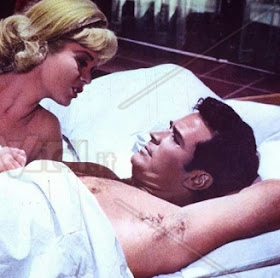The Dick Van Dyke Show won 15 Emmies during its five seasons (1961-1966), and is constantly praised today as one of the greatest TV shows of all time (TV Guide ranks it at #13).
It came on before my bedtime during its original run, but it was constantly being rerun during my childhood, often at lunchtime during the summer, so my brother and I watched while waiting for Mom to fry our baloney or egg sandwiches
I know, it's a classic, and it won lots of Emmies, and all, but I didn't like it.
1. The premise: Rob Petrie (Dick Van Dyke) was head writer for a weekly comedy-variety show. Stories alternated between work and home. Father of beefcake actor Barry Van Dyke (but no relation to Philip Van Dyke), Dick was tall, gawky, and rubbery-limbed, not at all attractive.
Plus he was hetero-horny in that obnoxious eye-bulging 1950s way, although devoted to his wife, Laura (Mary Tyler Moore, who would get her own iconic tv sitcom in the 1970s).
2. Rob's writing staff included the unhappily single, man-hungry Sally Rogers (Rose Marie), who was desperate to get married, even though that would mean giving up her successful comedy-writing career.
And short, sarcastic Buddy Sorrell (Morey Amsterdam). Cute, but in his 50s, a bit too old to be attractive to a preteen.
He was as hetero-horney as Rob, and married to a former chorus girl with the ridiculous name Pickles.
3. Buddy had a sparring love-hate relationship with Mel Cooley (Richard Deacon), the balding, stuffy producer of the tv show. But it was mostly hate. You have to push really hard to find an undertow of homoerotic attraction.
Richard Deacon was gay in real life, and a fixture in West Hollywood bars during the 1970s. My friend Levi dated him.
4. Back home, Rob and Laura had a son, Ritchie (Larry Mathews), who was about my age. But I don't recall him being the focus of any episode, except one where they explain how he got the feminine middle name "Rosebud." He was mostly a non-entity.
5. The only regular cast member who was marginally attractive was next door neighbor Jerry Helper, played Jerry Paris, who starred in some sex comedies during the 1960s. But he was married, too.
6. And maybe an occasional guest star, such as Jerry Van Dyke (left), Jamie Farr, and Jacques Bergerac.
No muscles, no buddy-bonding, a lot of hetero-horniness. No wonder I didn't like it.
Besides, the episode "It May Look Like a Walnut" scared me to death.





I remember watching it on Nick at Nite, I thought it was 50s, but it was early 60s. Same difference, I guess. I thought of color shows as post-1965 or thereabouts and black and white as before that.
ReplyDeleteMost network tv shows transitioned to color in 1965, and the rest by 1968, but a lot of people didn't buy color tv sets until later, and portable tvs were only black and white until the 1980s.
DeleteYou are right that the show was a celebration on heterosexist mid century America
ReplyDelete